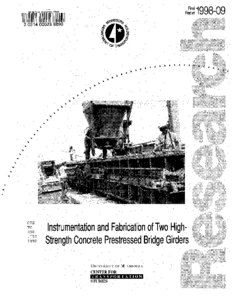Shear Capacity of High-Strength Concrete Pre-stressed Girders
Date Created
1998-05
Report Number
1998-12
Description
Instrumentation and Fabrication of Two High-Strength Concrete Prestressed Bridge Girders
Date Created
1998-01
Report Number
1998-09
Description
Ten-Year Review of Monitoring System on I-35W Saint Anthony Falls Bridge
Date Created
2020
Report Number
2020-19
Description
Displacement Monitoring of I-35W Saint Anthony Falls Bridge with Current Vibration-Based System
Date Created
2019
Report Number
2019-05
Description
Feasibility of Vibration-Based Long-Term Bridge Monitoring Using the I-35W St. Anthony Falls Bridge
Date Created
2017
Report Number
2017-01
Description
Investigation of Shear Distribution Factors in Prestressed Concrete Girder Bridges
Date Created
2016
Report Number
2016-32
Description
Modeling and Monitoring the Long-Term Behavior of Post-Tensioned Concrete Bridges
Date Created
2014
Report Number
2014-39
Description










